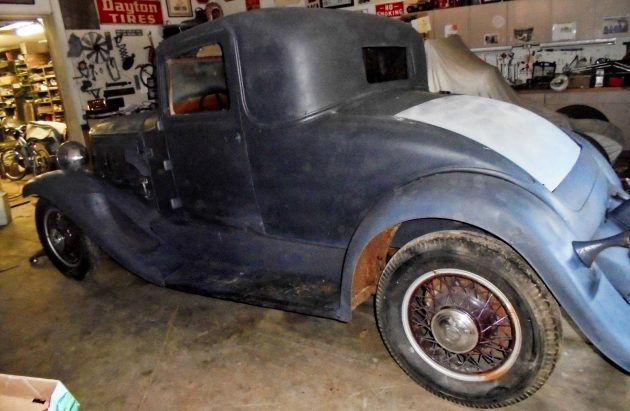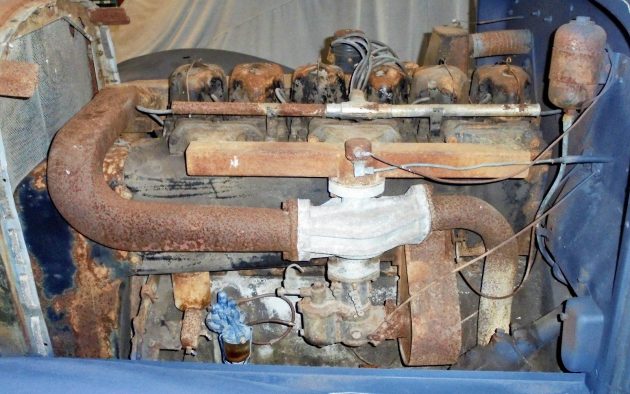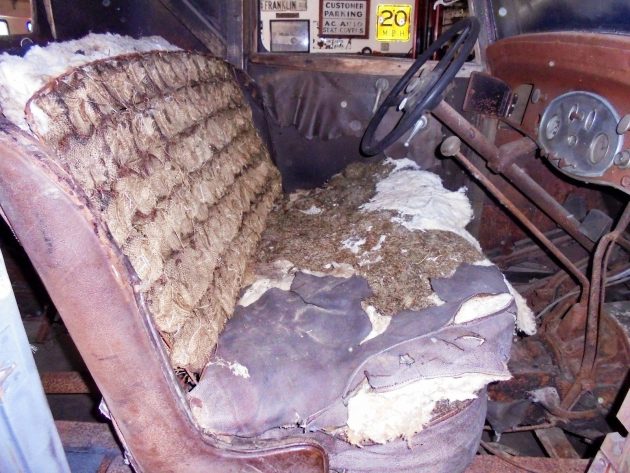If you are on the hunt for a vehicle that is truly special, look no further than this 1932 Franklin. This Airman 3 window coupe features impressive styling for it’s time and even more impressive technology. The big air cooled inline six is equipped with a supercharger and helped get power up to 100 horsepower and allowed this deuce coupe to reach speeds over 80 mph. This rare machine has been parked for many years and the seller had had plans to restore it, but they’ve realized they aren’t ever going to get to it. So, it’s now up for grabs here on eBay with a current bid just over $9k and only 2 hours to go.
Restoring this car will be a difficult and expensive undertaking, but boy will it be incredible when it’s done! Let’s just hope the engine doesn’t have any major issues. The seller claims it’s complete and turns over by hand, so that’s hopeful. All the other major mechanical systems are said to be intact as well, but there’s no word on their condition.
The closer you look this car over, the more you notice similarities between it and Ford’s deuce coupe. It would be rather fascinating to park them side by side to compare them. That is of course after finishing the restoration of this one. And as you can see on the inside, there’s a lot of restoration work to be done.
This really is an incredible machine and the current bid really doesn’t seem that bad considering just how rare it is. The cost to restore it could get astronomical, but if you are willing to do much of the work yourself, it might not be too bad. The seller has lots of parts for it and knows of people who have parts to help restore it. So would you take on this deuce coupe or do you think it will get far too expensive to justify?





For whatever reason, Franklin’s seldom command high prices either restored or unrestored. If it were mine, I would forget about perfection and resale value and just do a nice driver level restoration. It would be the hit of any car show.
If it ain’t mainstream Americans dont it ( :
Screaming to be a 50’s period correct Hotrod.Good Luck to the lucky winner. Looks like its been chopped already!!!
Is that Supercharged, Or turbo charged?
After a little search, it seems the car is Supercharged, using air from the Cooling fan for induction ? I have to wonder how effective that was.
Nobody was turbocharging cars at this time. Pretty sure the Olds F85 Jetfire was the first production turbo in 1962.
You may want to google the first turbocharger. It was pretty early. Ain’t nothin’ new on cars except putors.
You are correct, mostly. The Jetfire was one of two cars to claim “first turbocharged production passenger car.” The other, also in ’62, was the Corvair Monza. Someone put a turbo on a diesel truck back in the ’30s, but these were the first production automobiles with turbos.
cord and auburns were running superchargers in the 30s and so was willys knight cars
Don’t forget the 1962 Corvair Spider as well 150 HP.
According to Wikipedia Daimler got the patent for a forced induction device. Forced induction it was termed dates from the late 19th century, when Gottlieb Daimler patented the technique of using a gear-driven pump to force air into an internal combustion engine in 1885.[4] The turbocharger was invented by Swiss engineer Alfred Büchi (1879–1959), the head of diesel engine research at Gebrüder Sulzer (now called Sulzer), engine manufacturing company in Winterthur,[5] who received a patent in 1905 for using a compressor driven by exhaust gases to force air into an internal combustion engine to increase power output, but it took another 20 years for the idea to come to fruition.[6][7] During World War I French engineer Auguste Rateau fitted turbochargers to Renault engines powering various French fighters with some success.[8] In 1918, General Electric engineer Sanford Alexander Moss attached a turbocharger to a V12 Liberty aircraft engine. The engine was tested at Pikes Peak in Colorado at 14,000 ft (4,300 m) to demonstrate that it could eliminate the power loss usually experienced in internal combustion engines as a result of reduced air pressure and density at high altitude. accessed 12-23-2017
This is definitely a “Leno” type project deserving of a “Pebble Beach” restoration. 100 hp is impressive at that time.
Looks like an air turbine driven partly by the cooling fan, with an electric assist, it that’s a small motor atop the aluminum turbine housing. Fascinating bit of engineering – wonder what sort of boost it could achieve? Sure can’t seen any connection to the exh. manifold….
The “supercharger” is not what you usually think but added cold induction from the forced cold air coiling the engine.
This is a full CCCA classic and a great car worthy of a restoration. Hot rodding it would be a crime and a dumb ass idea.
There are maybe 3 or 4 of these known.
Superchargers take up energy to drive them[belts,chains etc] whereas a turbocharger utilises waste exhaust gas turning a turbine that forces cool air into the cylinder head with gas giving more efficient energy.
AS per Wikipedia. “The world’s first series-produced cars[6] with superchargers were Mercedes 6/25/40 hp and Mercedes 10/40/65 hp. Both models were introduced in 1921 and had Roots superchargers. They were distinguished as “Kompressor” models, the origin of the Mercedes-Benz badging which continues today”. The Olds only appeared 40 years later.
Superchargers were made first by Mercedes. Turbos came later with the Olds and Monza. Ya’all are both correct ….
They were talking about turbocharged, not supercharged cars.
Winning bid:US $9,958.00
[ 30 bids ]
That sounds like a bargain, considering the rarity of this car. Compare that to what a 32 Ford that was this original would cost. Although this would cost tremendously more to do a proper restoration.
About 30 years ago we had a ’32 Airman come in for engine & transmission work. If I remember correctly, the “Supercharger” was more like a primitive turbocharger. While there was a duct from the engine cooling air to the carb, that was a horizontal air duct, and the engine cooling was ducted downward. The reason for the ducted air into the carb was not really to take advantage of the air pressure boost [there really wasn’t any], but to pull in heated air when the engine was warming up.
The “supercharger” was an aluminum housing directly above the carb, and was bolted between the exhaust manifold and front exhaust pipe, on a horizontal path for the exhaust gases. There was an “outer” path for the exhaust to go thru a squirrel cage fan, and an inner fan for intake air, with blades similar to what was found on a typical table fan in a home in the 1930s.
We didn’t do any work on the supercharger unit, it was frozen and the shaft would not turn. I suspect from corrosion resulting from the aluminum housing and steel shaft having caused the corrosion from dissimilar metals. I really can’t see how this unit did anything for Franklin’s engines, except to give them a theoretical sales advantage.
While the basic unit was a primitive turbocharger, that word didn’t have the panache that “Supercharger” did with the public. In the early 1930s, cars with superchargers were considered fairly exotic, and Franklin was probably looking for anything that would give them an edge in creating sales, in the middle of the depression.
That was my thought while studying the pictures. It looked like the exhaust gas was routed thru the body of the “Suoercharger” hence making me think this was a Turbo Charger.
Is the Airman series a true classic? I thought the Airman was a less expensive series – and wasn’t there some relationship with REO to provide bodies? Or am I dreaming???? Rare and unusual car to say the least.
The main thing keeping me from taking on a Franklin is that they have a wooden frame.
I knew early ones had a wooden frame but didn’t realize a car as late as ’32 still had one!
That’s what I attributed their being undervalued to-and weren’t Morgan’s wooden framed up to recent?
Steel frame not wooden!
Come on guys. Full CCCA Classic too.
And the ’35 Chevy Standard still had wood framing above the chassis, although the Master series was all metal, and my ’39 MG was wood framed above the chassis as well.